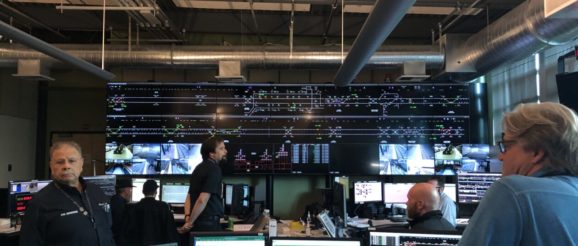How tech keeps Seattle’s transit system running — and why more innovation could be coming


Amid a sea of green rectangles on a computer monitor, one had turned red. A RapidRide bus — the red rectangle — was travelling a bit too rapidly.
It was almost 11 a.m. on Friday in the King County Metro Transit Control Center (TCC). Coordinators sat in front of large monitors, tracking the county’s GPS-enabled buses and communicating with drivers as needed.
Within seconds after the bus icon turned red, Sam Aulava, the coordinator at the desk, radioed the bus driver. “Good morning, you’re running a little hot,” he said. “If you keep going the rate you’re going, you’re going to leave some passengers for your follower.”
After hanging up, the coordinator turned to the group of individuals touring the TCC, including U.S. Rep. Suzan DelBene and Sen. Maria Cantwell. “Hopefully he’ll say ‘thank you,’ instead of saying ‘no, I’m not running hot,’” Aulava said, smiling.
DelBene hosted a tour of the TCC and a roundtable discussion Friday about the future of “smart cities” with other stakeholders including Rep. Ben Ray Luján (N.M.) and experts on tech and policy. DelBene and Cantwell introduced a bill in Congress in May that seeks $1.1 billion in federal funding over five years for smart city technologies.

The event on Friday included a tour of the TCC, where King County is already using technology to improve how people get around the Seattle area. On working weekdays, around 400,000 passengers travel via King County Metro Transit.
During peak weekday hours, seven bus coordinators manage the flow of buses at large desks with several monitors. They respond to alerts about emergencies on the road and are able to tweak bus schedules, adding or removing trips when required.
Each coordinator has a light over their desk that can flash either green, red, or blue. When the light is green, it indicates that the coordinator is listening on the radio, red shows that they’re talking on the radio, and blue that they’re speaking on the phone.
In the same room, other coordinators send messages to passengers via text, email, and Twitter, updating them about delays and other disruptions.
“Controllers” sit in an adjacent room and monitor the Link light rail. All the desks in the room face a set of large displays on the far wall, including cameras of train platforms and tracks. The controllers deal with diversions and other safety concerns when, for example, work crews are repairing tracks. They also help manage safety processes, including a deluge system that floods train areas in case of fire.

King County Transit officials know that tech can help bring about more efficiencies. For example, they are eager for the TCC to be able to communicate more rapidly with other local authorities via a “virtual command center.” The VCC would be a real-time repository that consolidates the TCC’s information with updates that other public bodies, including the fire department, police, and state patrol, had entered into their own dispatch systems.
“They could also see what we’re doing and they could say ‘hey, Metro, if you’re sending your buses this way, maybe we can set up some dedicated lanes for you, or get some police officers out there to help you get through,’” said Jeff Wamsley, superintendent of bus operations at the TCC.
The VCC is in preliminary stages of development and could take at least one to two years to come to fruition, said Rob Gannon, general manager of King County Metro.
DelBene hopes that the smart cities bill can help entities such as King County Metro test and eventually implement new tools.
“That’s really the goal of our legislation — to create funds for pilots, so that people can really create these test beds, try something out, and that learning can be shared,” she said.
Several of the roundtable panelists on Friday emphasised the importance of engaging community members in smart city initiatives. “It’s not necessarily a technology-only endeavour,” said Cameron Carr, director of IoT solutions at Microsoft, but rather one that involves factors like “economic development, relationships, how people feel about things,” and more.
“It’s not just a conversation about how we deploy this technology. It’s about how we create a virtuous partnership across so many different parties,” he added.
Carr pointed to the city of Houston, which has been at the forefront of IoT solutions integrated with communities and public services, especially when it comes to school safety systems, he said. Last year Microsoft partnered with Houston officials on a smart city initiative.
DelBene, a Democrat who was elected in 2012, also vouched for information sharing between communities “so if one person learns, ‘hey this doesn’t work that well in this type of scenario,’ other communities know.”
“It makes public investment a little easier going forward,” she said.
Unsurprisingly, questions of privacy and data security came up during Friday’s discussion.
“You don’t want brand new stuff that hasn’t been tested or tried,” said Ginger Armbruster, Seattle’s chief privacy officer. “Some of the companies we work with don’t have a data plan, they don’t really know what they’re doing with the data they collect … or, they haven’t really tried the system out with the kind of rigor we would need to say it’s stable.”
Armbruster said federal government assistance could be welcome when it comes to supporting incubators, and helping cities “find good solutions and ways to really test those out, so we don’t make a financial commitment only to find out that we need something else.”
Other experts in the room on Friday included Bill Howe, director of the eScience Institute at the University of Washington; Kim Johnston, government and external affairs director at Snohomish PUD; Marcia Garrett, director of regional relations at Washington State University; Rex St. John, senior manager of the IoT Ecosystem at Arm; and Michael Mattmiller, director of government affairs at Microsoft, who moderated.
